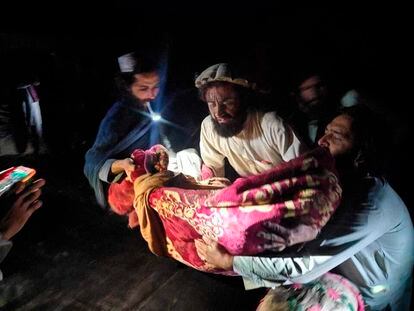Afghanistan's emergency teams are working around the clock this Thursday to reach and assist the victims of the earthquake that shook the southeastern fringe of the country early on Wednesday.
More than a thousand people lost their lives due to the earthquake, according to a provisional balance that could grow due to the seriousness of the condition of many of the injured and that many of the affected areas, located in mountainous terrain, are inaccessible.
Added to this is the lack of resources in the Central Asian country, ruled by the Taliban since August last year, and the heavy rains that have hit the region in recent days.
Kabul has asked the international community for help to deal with the emergency and the Prime Minister of Afghanistan, Mullah Mohammad Hassan, announced this Thursday,
More information
Hunger consumes Afghanistan after the arrival of the Taliban
The earthquake, of magnitude 5.9, occurred early Wednesday (local time) in a poor rural area and difficult to access, on the border with Pakistan.
In the midst of a serious economic and humanitarian crisis, the tremor plunged Afghanistan into a new tragedy, a tough challenge for the Taliban, 10 months after regaining power after the withdrawal of international forces led by the United States.
It is the deadliest earthquake in Afghanistan in two decades.
More than 1,000 people have died and 1,500 have been injured in the province of Paktika, the most affected, according to the authorities.
These figures would not include casualties in adjacent Jost, epicenter of the quake.
Kabul fears the death toll will rise as many people remain trapped under the rubble of their collapsed houses.
"The rescue operations have ended," said the Taliban spokesman in the region, Mohammad Ismail Muawiyah: "No one is trapped."
For their part, ministerial sources have clarified that in some specific areas these aid efforts continue.
“It is very difficult to get information from the countryside due to the poor [telephone] network,” Mohammad Amin Huzaifa, head of the Information and Culture Department of Paktika province, said on Thursday.
"The affected sites are difficult to access," said Huzaifa, especially as the area has been affected by flooding caused by heavy rains.
According to the Afghan information channel Tolo News, at least 400 people have died from the storm, which has also caused landslides, which have slowed down rescue efforts and damaged telephone lines and power lines.
The Taliban government, which has a very limited number of helicopters to deal with this emergency, has mobilized the Army.
However, its financial resources are very limited after the freezing of billions of assets abroad and the abrupt interruption of international aid, which has been present for the last 20 years and has only returned in a trickle since the return to power of the fundamentalists.
photo gallery
The Afghanistan earthquake in pictures
The UN has reported that at least 2,000 houses had been destroyed, each of which was inhabited by seven or eight people.
The Kabul regime has asked for help from the international community, which has so far refused to recognize it, and from humanitarian organizations.
The Secretary General of the United Nations, António Guterres, has assured that the UN is "fully mobilized" to help Afghanistan, with the deployment of first aid teams and the shipment of medicine and food.
The organization calculates that the necessary investment to assist the country for three months is 15 million dollars (14.3 million euros).
The affected population urgently needs shelter, due to the rains and unusual cold this season, but also food aid, water, hygiene and sanitation, according to the UN Office for the Coordination of Humanitarian Affairs (OCHA, in its acronym). in English).
The Taliban announced this Thursday that they had received two planes loaded with aid from Iran and another from Qatar.
Eight truckloads of food and first aid supplies have arrived from neighboring Pakistan.
In addition, this Thursday, a convoy has left Kabul to serve "4,000 people": "With tents, blankets and other relief items to protect them from bad weather and meet their immediate needs," announced the representative of the UN Agency for Refugees (UNHCR) in Afghanistan, Leonard Zulu, on Twitter.
The World Food Program (WFP) has confirmed that it has food reserves to serve 14,000 people in Paktika, while the World Health Organization (WHO) has dispatched ten tons of medical supplies, enough for 5,400 surgeries and medical treatments to cover 36,000 people for three months.
The European Union has also stated its readiness to “provide emergency assistance”.
For its part, the United States, which has declared itself “deeply saddened”, has communicated that they are examining their humanitarian “response options”.
Under-equipped, the Afghan health system is also under a lot of pressure.
“Our country is poor and lacks resources.
It is a humanitarian crisis;
it is like a tsunami”, said Mohammad Yahya Wiar, director of the hospital in Sharan, capital of Paktika.
Apart from assistance and medical supplies, the Taliban have requested the support of the WASH program, in charge of sanitizing and sanitizing the water so that it is suitable for human consumption, and avoiding diseases.
“Cholera outbreaks after earthquakes are a cause for serious concern.
500,000 cases of acute watery diarrhea have already been confirmed throughout the country”, they have warned from the OCHA: “The preparations to avoid an outbreak are underway”.
Afghanistan frequently suffers the horror of earthquakes, especially in the Hindu Kush mountain range, which sits at the junction of the Eurasian and Indian tectonic plates.
These disasters can be particularly destructive due to the poor resistance of rural Afghan houses.
The deadliest earthquake in the recent history of Afghanistan, with around 5,000 dead, took place in May 1998 in the provinces of Tajar and Badajshan, in the northeast of the country.
Follow all the international information on
and
, or in
our weekly newsletter
.

